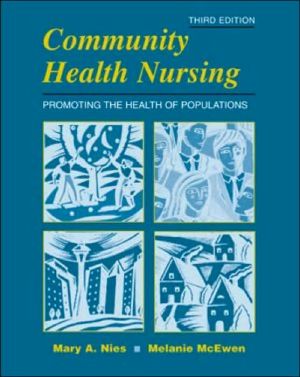

 |

|

The average rating for Community Health Nursing: Promoting the Health of Populations based on 2 reviews is 4 stars.
Review # 1 was written on 2015-04-11 00:00:00 Lois Lightfoot Lois Lightfootfrom my blog, with links for citations and further info: Who knew? Community health nurses hail from a social justice warrior tradition. It seems timely to recall that, in a time when gaps between America's rich and the poor have grown, even during our ostensible "recovery" (Wall Street Journal: Gap Between). It also seems a fitting time to reclaim the term in the book world, as some authors have been out to make it a term of derision. Community health nursing in America hails from 1893 when nurses Lillian Wald and Mary Brewster created a district nursing service on the Lower East Side of New York City, a homeless and immigrant community (House on Henry Street). So nurses have a long tradition of advocating for the under-served in society. It's news to me, because despite being at a unionized hospital, most nurses I know seem pretty content with the general economic order. It's tough work to get them to unionize for their own rights, let alone campaign to improve the lives of others. And we frequently seem to fall prey to the common thinking error of "they brought this on themselves," perhaps to enable us to stay in our comfort zones. And perhaps a bit of compassion fatigue. At any rate, Community/Public Health Nursing does a fabulous job of taking the reader through what community health nursing is, theoretical models of improving health of the community and epidemiology, the study of health and disease in the human population. One of the key concepts is that preventing problems ("thinking upstream") is easier than fixing them. It goes on to suggest ways of assessing a community, planning projects and providing education. A sizeable chunk is devoted to influencing factors in health, including legislation, the health care system and economics. Another section is devoted to aggregate issues: special topics in children's and senior health, men's and women's health. Vulnerable populations include people affected by disabilities, homeless, rural and migrant health and the mentally ill. Another section looks at general population issues, including violence, substance abuse, infectious disease, and disasters. The final chapters examine various roles the nurse can have in community health, whether forensic and correctional nursing, school, parish and occupational nursing. Holy review of the public health system, Batman, but did it ever cover a lot of material. Strengths include a very current approach, relating it to national health goals called "Healthy People 2020." (link on site). Case studies at the end of the chapter show the ways the material can be taken from the individual scenario out to the community population. Weaknesses were few. I'd say the general population issues section was the lightest on material, particularly disasters and violence. As I enter my final phase of classes, it's interesting to reflect on what I'm learning versus what I'm seeing. The hospital/clinic medical system is very individual and problem-driven. In fact, it's pretty much the opposite of community health. But what concerns me is that despite the efforts of Obamacare-which was attempting to hold the medical system accountable, and to move health care toward prevention-our current Congress is doing its level best to dismantle the safety net we have in place. America is absolutely dismal when it comes to health care. We spend more per capita--roughly $9,000--than anyone but Switzerland and Norway (Health Expenditures, World Bank), and yet most people would agree many of our health statistics remain alarming. We're 23rd in infant mortality among industrialized nations, tied with Serbia and Bosnia for 6 deaths per 1000 infants born (Mortality Rate, World Bank). Measles is on the rise. Suicides remain high. Something in how Americans are approaching and managing health care is clearly not working. But instead of complaining about the tiny amounts we pay for school health services and serving and managing vulnerable populations, or fighting to dismantle the small progress we've made, we need to start thinking outside the box. And don't get me started on managing violence and guns. There's a reason the U.S. has almost FOUR times the rate of Great Britain when it comes to "intentional injuries" related to violence (WHO Database; "all persons"). So, great book. Very informative, very validating. Now time to get our health agendas in gear, nurses! |
Review # 2 was written on 2020-07-29 00:00:00 Charles Stonehouse Charles StonehouseNc |
CAN'T FIND WHAT YOU'RE LOOKING FOR? CLICK HERE!!!